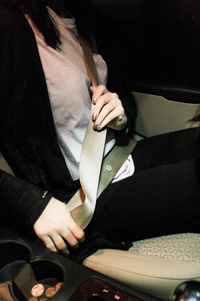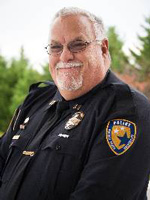One student survives a car crash without being buckled up.
Meanwhile, officers have made more than 100 seatbelt stops in 2016.
Story by Abby Siegel, Assistant News Editor

She was driving the short route home to the Chase. She was pulling out from the CFSB Center in the evening on Feb. 8 when the stoplight turned green, signaling it was her turn to proceed.
That’s when a State Trooper hit her blue 2003 Saturn Vue with his blue lights flashing as he rushed through the intersection to the scene of a crime. Her car fishtailed, flipping on its side.
Her Saturn was totaled; its windows shattered from the impact of the collision. The State Trooper’s vehicle barely showed signs of the crash.
Ellie LeBeau, senior from Belleville, Illinois, wasn’t wearing her seatbelt the day she was hit in the collision that was neither her fault nor the State Trooper’s.
“I was so thrown off,” she said. “I didn’t see the lights until the second he hit me.”
Within five minutes, LeBeau said she was rushed to the hospital. Her injuries included bruising on her leg, head pain and a chipped front tooth, which caused her to need a fake tooth. She said she has fully recovered from the collision that occurred about three weeks ago.
“I know I was really lucky,” she said.
IT’S THE LAW
Between Jan. 1 and March 7, Public Safety and Emergency Management officers have conducted 100 traffic stops for people not wearing a seatbelt or not wearing it properly on or around campus. The 100 reports are inclusive of drivers of any age, not just Murray State students.
Public Safety’s Captain of Operations, Robert Bringhurst, said about 80 percent of people on the road wear their seatbelt and about 20 percent do not within Murray. Public Safety officers patrol the city when days are slow regarding calls, but they don’t intentionally seek to give citations, he said.
LeBeau said she often didn’t wear her seatbelt before her wreck because of the small size of Murray and the fact that it only takes “two minutes to get anywhere.”
According to the Kentucky Transportation Cabinet’s Office of Highway Safety, most crash deaths occur within 25 miles of the driver’s home and at speeds less than 40 mph.
According to the office, an unbelted person hitting the windshield going 40 mph would have the same force on the person hitting the ground after falling from a five-story building.
Kentucky has a primary seatbelt law, meaning drivers can be stopped if anyone in the vehicle is not wearing a seatbelt. Because of the state law, all $25 fines attached to seatbelt citations don’t go back to Murray State or Public Safety.

The Calloway County Attorney’s office created an aversion program in which the fee would still need to be paid, but the citation would not go on the driver’s record unless the citation occurred a second time, Bringhurst said.
HABIT CHANGE
Since her accident, LeBeau said she has made a habit change from the “scarring” incident. She said her perspective has changed on the importance of always wearing a seatbelt.
“I think I got a call from every single person in my family saying ‘you’re an idiot, wear your seatbelt next time’ and ‘I hope you learned your lesson,’” LeBeau said.
The habit of not wearing a seatbelt spans all ages, but people ages 30 to 50 are more apt not to wear their seatbelts, Bringhurst said.
“When those folks were learning to drive, there wasn’t a mandatory law,” he said. “Old habits are hard to break.”
Kentucky began the “Click It or Ticket” campaign in 2011 to emphasize the mandatory seatbelt law that placed a special focus on wearing a seatbelt during nighttime hours.
In 2010, 162 people died in Kentucky between the hours of 9 p.m. and 6 a.m. as a result of not wearing a seatbelt, according to Kentucky state records.
“It took a second to get used to being behind the wheel and feeling comfortable again,” LeBeau said.
She said she is now practicing a new way of driving – defensive driving – where she anticipates the actions of other drivers and is alert of weather conditions to ensure her safety and the safety of others.
“You have to watch out, even if you are following all the laws,” LeBeau said.